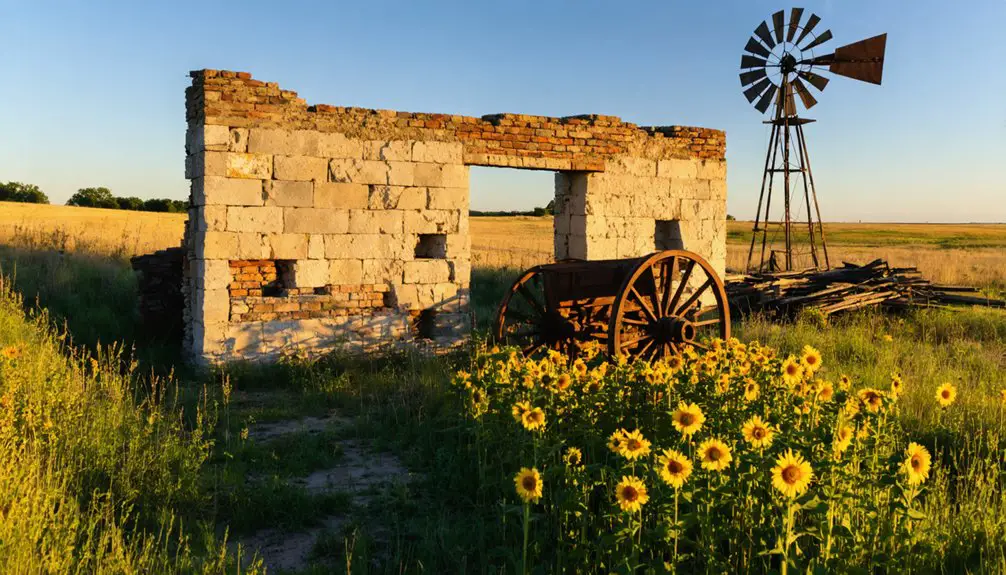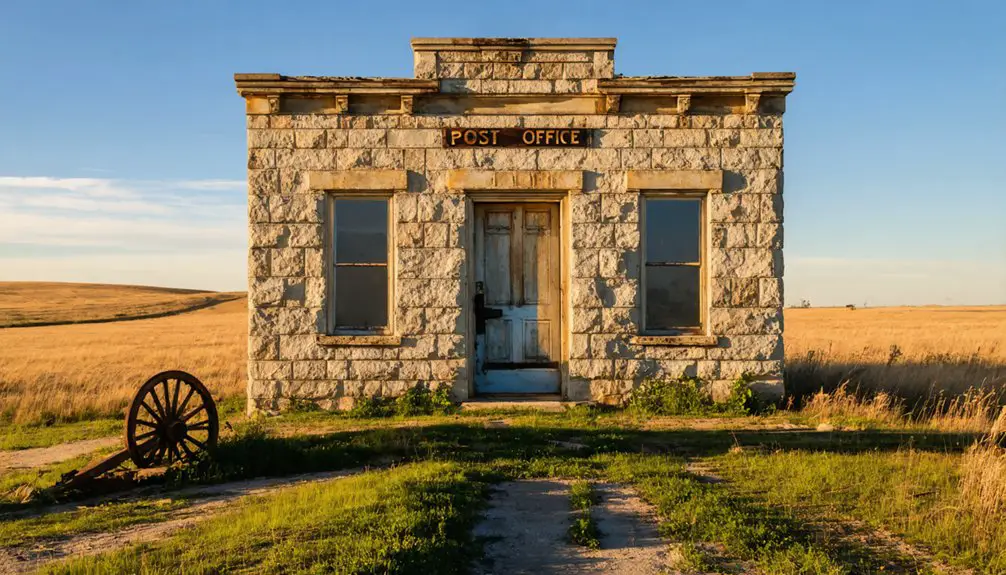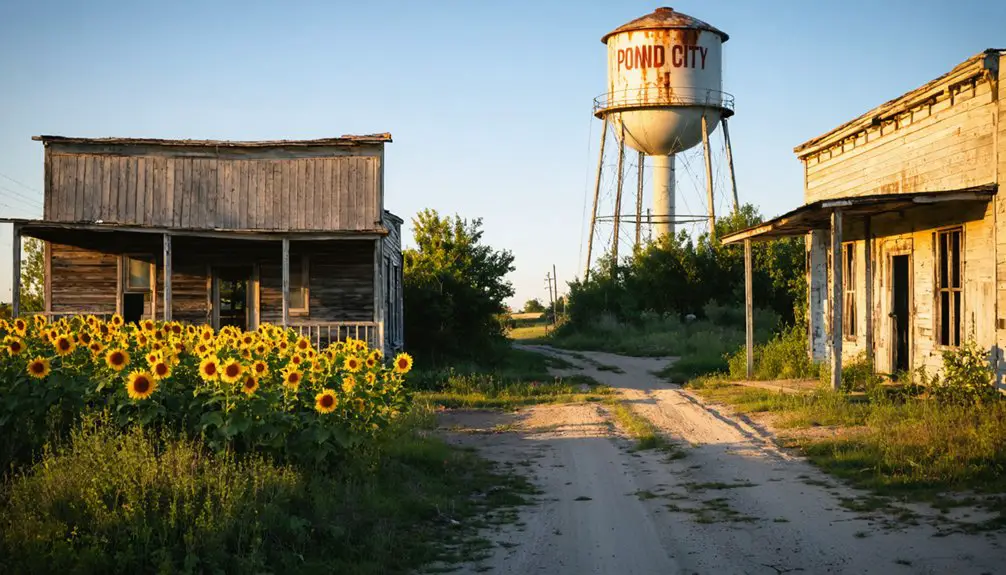You’ll find Pond City among Kansas’s notable ghost towns, established in the 1850s during the contentious Kansas Territory period. The settlement featured a prominent grain elevator along railroad tracks, a military fort-turned-post office, and an essential blacksmith shop that served as a community hub. While economic challenges and rural depopulation led to its decline by the early 20th century, the town’s physical remnants and archived records reveal a deeper story of pioneer resilience and territorial struggles.
Key Takeaways
- Pond City was a Kansas settlement established in the 1850s, featuring a grain elevator, military fort-turned-post office, and railway connection.
- The town’s economic backbone included a blacksmith shop, hotel, general store, and school building that operated until 1935.
- The arrival of the Atchison, Topeka and Santa Fe Railway initially boosted growth but couldn’t prevent eventual economic decline.
- Rural depopulation and competition from larger cities led to Pond City’s abandonment in the early 20th century.
- Historical preservation continues through documentation, photography, oral histories, and cemetery maintenance efforts by Lyon County archives.
Origins in Kansas Territory
When Congress passed the Kansas-Nebraska Act in 1854, it established the Kansas Territory alongside Nebraska Territory, setting the stage for Pond City’s eventual founding.
You’ll find that the Act’s introduction of popular sovereignty created a volatile environment where pro-slavery and anti-slavery settlers competed for control of the region’s future.
The Territory saw intense conflicts as Border Ruffians from Missouri entered Kansas to influence voting outcomes.
As territorial governance took shape, early settlers formed informal squatter’s associations before formal county structures emerged.
These associations helped maintain order as newcomers arrived, particularly along the Missouri and Kansas Rivers where most early towns developed.
While the Territory’s legal framework upheld existing Native American treaties, pressure from European American settlement intensified.
Like many Kansas settlements of this era, Pond City emerged during a time when economic interests in land speculation intertwined with the broader political struggle over slavery’s expansion westward.
The influx of settlers dramatically impacted Native American tribes as forced relocations displaced many indigenous communities from their ancestral lands.
Early Pioneer Settlement Life
As settlers established themselves in Pond City during the 1850s, they faced the relentless demands of frontier life that required complete self-sufficiency.
You’d find pioneer hardships divided along traditional community roles, with women working from dawn to dusk on domestic tasks while men managed crops and livestock. Your daily survival meant hauling water from streams, preserving food for winter, and crafting essential items from scratch. Living in a sod house built from squares of earth was common due to the lack of trees on the plains.
Life was especially challenging for women who endured isolation in rudimentary homes miles from their nearest neighbors. These women often found comfort through church social gatherings that provided rare opportunities for community connection.
You’d have to make your own clothing using wool you’d spun yourself, preserve fruits and vegetables from your garden, and cope with constant threats from severe weather, illness, and regional conflicts.
The harsh Kansas climate and limited resources tested every family’s resilience.
Notable Buildings and Infrastructure
The remnants of Pond City’s infrastructure paint a portrait of its brief but significant role in Kansas frontier development.
You’ll find the ghost town architecture centered around a prominent grain elevator that stands along the railroad tracks, representing the heart of the town’s agricultural infrastructure.
Near the Simon River crossing, a military fort-turned-post office once protected travelers and later served as an essential communication hub.
The old school building, relocated in 1924 and operational until 1935, reflects the community’s educational aspirations.
While most structures have succumbed to time, you can still spot an unoccupied house near the elevator, along with traces of the former commercial district that included a hotel, general store, and lumber yard.
Like many Kansas towns established in the 1870s during the era of railroad expansion, Pond City grew around the promise of rail transportation.
The town’s original blacksmith shop played a vital role in serving the needs of local farmers and travelers during its peak years.
The Role of the Blacksmith Shop
Located at the heart of Pond City’s commercial district, a bustling blacksmith shop once served as both an important service hub and community gathering place.
You’d find locals congregating around the forge while the skilled craftsman shaped metal into tools, hardware, and equipment crucial for the town’s survival. Like the Whitsett & Strieby shop in Council Grove, these craftsmen were essential for travelers and settlers along major trade routes. The shop’s significance extended beyond its practical function, as it played a vital role in supporting local trade and commerce.
Beyond crafting essential tools and hardware, the blacksmith’s shop served as a vibrant nucleus of community life and commerce.
As you’d expect in a frontier town, the blacksmith’s expertise was indispensable for maintaining wagons, repairing farm implements, and crafting important items like nails and hinges. Similar to the historic Johnson and Lindblade partnership that created fire escapes, these skilled craftsmen were essential to public safety and infrastructure.
The rhythmic sound of hammer striking anvil and the glow of the coal-fired forge marked this community hub as a cornerstone of Pond City’s economic and social life.
Economic Forces Behind the Decline
While many Kansas farming communities faced economic challenges in the early 20th century, Pond City’s decline stemmed from a perfect storm of agricultural, industrial, and demographic shifts.
You’d have seen family farms struggle as rising costs and technological changes allowed fewer farmers to work larger tracts of land. This rural depopulation hit Pond City particularly hard when critical transportation links diminished, isolating the community from essential commerce routes. The rise of advanced farming technology meant that local support businesses were no longer needed in such numbers.
The town’s vulnerability increased as younger residents moved to urban areas seeking better opportunities. As the population dwindled, local businesses couldn’t sustain themselves, and necessary services disappeared. Similar to places like Coldwater and Protection, the town experienced a population halved since the 1930s.
Competition from larger nearby cities drew away remaining commerce, while the lack of economic diversification left Pond City unable to adapt. The result was a downward spiral that ultimately transformed this once-vibrant community into a ghost town.
Migration to Neighboring Towns
As Pond City’s economic prospects dimmed in the late 1800s, residents began migrating to neighboring towns that offered stronger transportation links and diversified economies.
You’ll find that migration patterns often led to county seats and railroad towns where steady employment in mining, trade, and transportation provided stability for displaced families.
Your ancestors’ choices were heavily influenced by political allegiances during Kansas’ turbulent pre-Civil War period, with Free State sympathizers typically heading to Lawrence while pro-slavery settlers moved toward Missouri.
Railroad access proved essential, as towns with rail stops attracted businesses and residents from Pond City.
Social networks and family connections helped determine where people settled, with most preferring established communities that offered schools, churches, and protection from regional conflicts.
Physical Remnants Today

The passage of time has left minimal physical evidence of Pond City’s existence. Today, you’ll find only scattered foundations, deteriorated cellars, and debris where buildings once stood.
Time erases all traces, leaving only crumbling foundations and scattered ruins where Pond City once thrived.
Natural reclamation has transformed the townsite into prairie and farmland, with vegetation steadily overtaking the remnants’ visibility.
While satellite imagery can reveal faint outlines of the original settlement beneath the overgrowth, you won’t see distinct streets or structures without historical maps.
The land is now largely private property used for agriculture and grazing, limiting public access to these ghost town ruins. No formal preservation efforts or archaeological excavations have taken place, though local historical societies maintain some artifacts and records.
Wildlife has reclaimed the abandoned site, creating new habitats where pioneers once built their dreams.
Historical Significance in Lyon County
Located within Lyon County’s rich historical tapestry, Pond City emerged during a pivotal period of Kansas settlement and development. As you explore the town’s story, you’ll find it intertwined with Lyon County’s establishment in 1862, named after Civil War hero General Lyon who fell at Wilson’s Creek.
Early settlers faced considerable challenges, from grasshopper raids to water scarcity, yet they persevered.
The region’s economic growth accelerated with the arrival of the Atchison, Topeka and Santa Fe Railway, transforming local trade and town development.
The county’s blend of forest and prairie landscapes shaped its agricultural history, with farmers adapting to the terrain’s unique characteristics.
Like many communities of its era, Pond City reflected the broader patterns of settlement that defined Lyon County’s evolution from frontier territory to established farming community.
Preserving the Town’s Legacy

You’ll find the legacy of Pond City preserved primarily through methodical documentation efforts, including detailed photography of remaining structures and the collection of oral histories from descendants of original settlers.
Historical records from Lyon County archives help reconstruct the town’s timeline through maps, newspaper clippings, and land ownership documents.
The town’s cemetery, though weathered by time, remains a focal point of preservation work, with local historical societies maintaining gravesites and recording genealogical information for future generations.
Historical Documentation Methods
Since Pond City’s disappearance from Kansas’s landscape, historians and researchers have employed diverse methods to document and preserve its legacy through systematic archival research, archaeological studies, and technological innovations.
By accessing digital archives and historical newspapers, you’ll discover detailed accounts of the town’s development and eventual decline. Community collaboration between historians, archaeologists, and local enthusiasts has strengthened preservation efforts through shared resources and knowledge.
You can trace Pond City’s physical layout through historical Sanborn and Beers maps, while archaeological investigations reveal tangible evidence of daily life.
Modern technology, including GIS mapping and 3D modeling, helps reconstruct the town’s appearance during its peak. These tools, combined with careful examination of surviving documents and artifacts, create a thorough understanding of Pond City’s historical significance.
Cemetery Preservation Efforts
Through dedicated community efforts, Pond City’s historic cemetery stands as one of the last physical remnants of this vanished Kansas town.
You’ll find regular volunteer cleanup initiatives working to clear debris and invasive vegetation, while professional restoration specialists help reset and repair damaged headstones. Local historical societies conduct educational workshops teaching proper gravestone care techniques, ensuring preservation work doesn’t harm these fragile markers.
Community engagement has proven crucial to the cemetery’s survival. Voter-approved funding supports ongoing maintenance, professional landscaping, and installation of interpretive signage.
You can participate in hands-on restoration activities or guided tours that highlight the site’s cultural significance. The cemetery department coordinates with volunteers and preservation groups, maintaining this essential link to Pond City’s past while protecting it for future generations.
Frequently Asked Questions
Were There Any Natural Water Features That Gave Pond City Its Name?
You’ll find historic records show natural seasonal ponds and wetlands served as essential water sources, giving Pond City its apt name. These shallow basins collected rainfall and supported early settlers’ needs.
What Happened to the Native American Populations in the Pond City Area?
You’ll find Native tribes like the Kansa, Osage, and others faced historical displacement through forced treaties and relocations, with their populations drastically declining due to disease, conflict, and buffalo extinction.
Did Any Significant Civil War Events Occur Near Pond City?
You’ll find the Civil War heavily impacted the region, with local skirmishes occurring nearby. The largest battle was Mine Creek, fought 30-40 miles away during Price’s 1864 Missouri campaign.
What Crops Were Primarily Grown by the Early Settlers?
Like pioneers breaking new ground, you’d find early settlers focusing heavily on corn cultivation as their main crop, with wheat production following as the second most important agricultural pursuit.
Were There Any Documented Paranormal Activities in Abandoned Pond City Structures?
You won’t find any verified ghost sightings or documented paranormal activity in Pond City’s haunted buildings. Historical records and paranormal investigation databases don’t mention supernatural occurrences in this abandoned settlement.
References
- https://dianastaresinicdeane.wordpress.com/2012/01/29/columbia-a-kansas-ghost-town-story/
- https://www.youtube.com/watch?v=gkfXLg-ftys
- https://legendsofkansas.com/kansas-ghost-town-list/
- https://www.youtube.com/watch?v=ie3zwwHm2Jg
- https://www.youtube.com/watch?v=OyBXD18P_j4
- https://en.wikipedia.org/wiki/Kansas_Territory
- https://en.wikipedia.org/wiki/History_of_Kansas
- https://civilwaronthewesternborder.org/encyclopedia/quindaro-kansas
- https://legendsofkansas.com/kansas-city-kansas/
- https://dpcountyks.com/doniphan-county-history/



